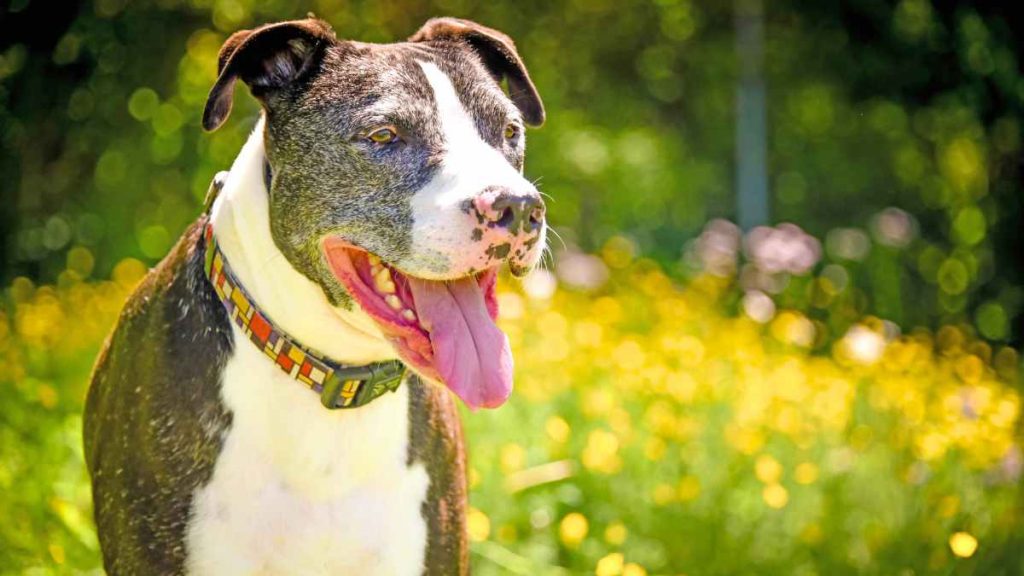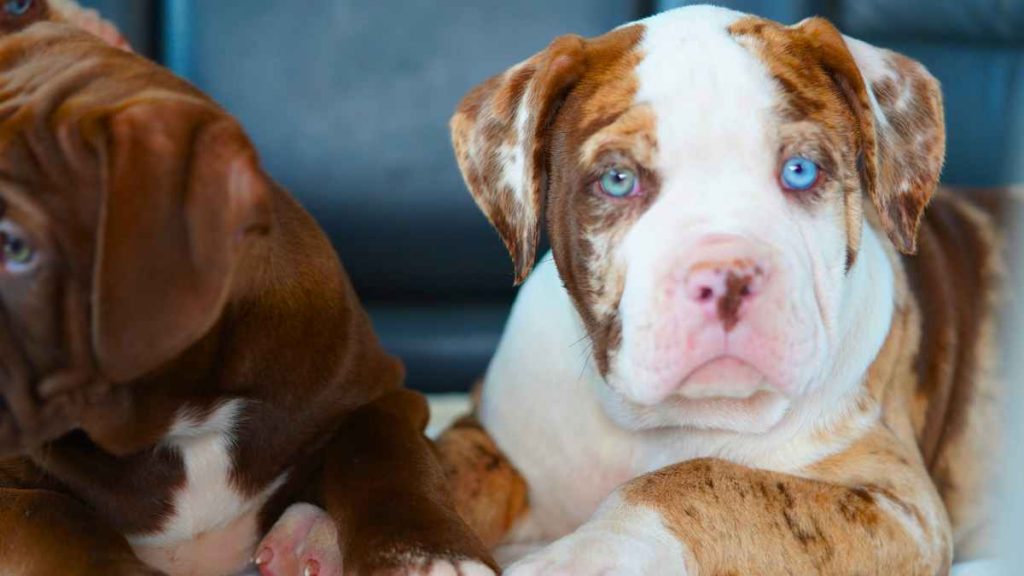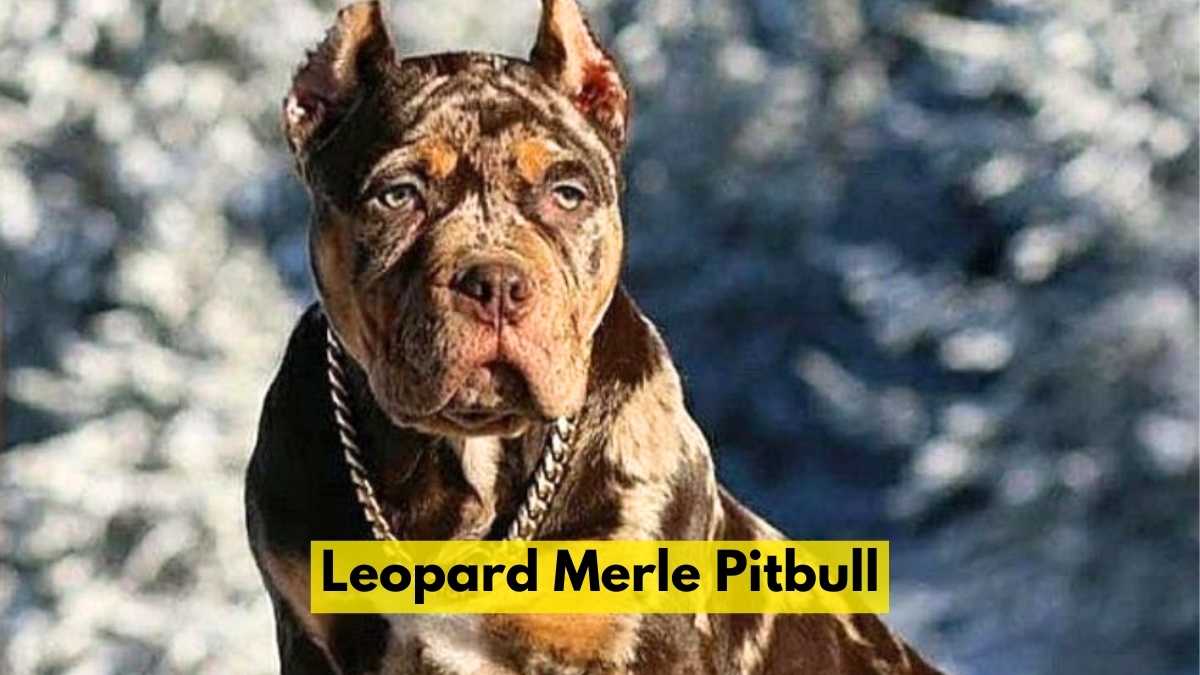As a proud dog owner, my life has been enriched by the presence of my beloved Leopard Merle Pitbull. This remarkable breed stands out with its captivating coat patterns, characterized by the striking combination of the Leopard and Merle genes. From the moment I laid eyes on my furry friend, I was captivated by their unique beauty and charm.
Leopard Merle Pitbulls possess an unparalleled grace and strength, both in their physical appearance and their endearing personality. With their muscular build and athletic prowess, they exude confidence and agility. However, it is their loving and loyal nature that truly sets them apart. Despite their strong presence, they have an innate ability to form deep connections and become cherished members of the family.
Being a responsible owner of a Leopard Merle Pitbull comes with its own set of considerations. From understanding their specific exercise and grooming needs to providing them with proper training and socialization, it is essential to ensure their well-being and happiness.
Join me as we delve into the world of Leopard Merle Pitbulls, exploring their unique traits, health considerations, training techniques, and the joy they bring to our lives.
Table of Contents
What is a Leopard Merle Pitbull?
A Leopard Merle Pitbull is a captivating and distinctive breed that combines the striking Leopard and Merle genes. This unique genetic combination results in a mesmerizing coat pattern characterized by spots and patches of various colors. These dogs have a muscular build, exuding strength and agility.
Leopard Merle Pitbulls are known for their loving and loyal nature, making them wonderful companions for dedicated dog owners. They form deep bonds with their families and are known to be highly protective. While their appearance may draw attention, it’s their endearing personality that truly sets them apart.
In addition to their remarkable looks, Leopard Merle Pitbulls possess a high level of intelligence and energy. They thrive with proper training and mental stimulation, making them excellent candidates for various dog sports and activities. However, it’s crucial to remember that they require consistent socialization and positive reinforcement training techniques to develop into well-rounded and obedient pets.
As with any breed, responsible ownership is vital. This includes meeting their exercise needs, providing proper nutrition, regular veterinary care, and ensuring a safe and loving environment. By understanding and appreciating the unique qualities of Leopard Merle Pitbulls, we can embrace their beauty and enrich our lives with their companionship.

Physical Characteristics
A. General Appearance and Size of Leopard Merle Pitbulls
Leopard Merle Pitbulls are medium-sized dogs with a strong and muscular build. They have a compact yet athletic physique, displaying power and agility in their movements. Standing at around 17 to 21 inches (43 to 53 cm) in height at the shoulder and weighing between 35 to 60 pounds (16 to 27 kg), they possess a sturdy frame that exudes strength and vitality.
B. Unique Coat Patterns and Colors
One of the most distinctive features of Leopard Merle Pitbulls is their eye-catching coat patterns and colors. The Leopard gene creates spots on their coat, resembling the markings of a leopard. These spots can vary in size, shape, and density, giving each dog an individualized and striking appearance. Combined with the Merle gene, which causes a dilution of pigmentation, Leopard Merle Pitbulls exhibit a captivating blend of colors, including black, brown, blue, gray, and tan. The combination of spots and patches creates a mesmerizing mosaic effect on their coat, making them truly stand out in a crowd.
C. Distinctive Features and Body Structure
Leopard Merle Pitbulls possess several distinctive features that contribute to their overall allure. They have well-defined and powerful jaws, complemented by a broad and expressive head. Their eyes, which can be of various colors including blue, amber, or brown, reflect their intelligence and alertness. Their ears are typically medium-sized and may be floppy or semi-erect.
In terms of body structure, Leopard Merle Pitbulls have a deep and broad chest, providing ample room for lung capacity and enhancing their physical endurance. Their back is strong and straight, while their legs are muscular and well-developed, enabling them to move with grace and agility. Overall, their physical appearance and body structure highlight their athleticism and inherent strength.
The unique combination of general appearance, size, striking coat patterns, and distinctive features make Leopard Merle Pitbulls a truly remarkable breed. Their physical characteristics not only make them visually appealing but also contribute to their remarkable agility and versatility. Whether participating in sports, working tasks, or simply being a loving family companion, Leopard Merle Pitbulls capture the attention and hearts of those fortunate enough to encounter them.
Temperament and Behavior
A. Understanding the Pitbull Temperament
Leopard Merle Pitbulls, like other Pitbull breeds, are known for their loving, loyal, and affectionate nature. They are often referred to as “people dogs” due to their strong desire to be close to their human family members. They thrive on human companionship and are known to be highly devoted and protective. With proper socialization and training, Leopard Merle Pitbulls can be gentle and friendly with people of all ages, including children.
B. Influences of the Merle Gene on Behavior
While the Merle gene primarily affects the coat coloration of Leopard Merle Pitbulls, it does not significantly impact their overall temperament and behavior. The behavioral traits of a Leopard Merle Pitbull are primarily shaped by their upbringing, training, and socialization experiences. It’s important to note that responsible breeding practices prioritize temperament and select for dogs with stable and well-rounded personalities.
C. Socialization and Training Considerations
Socialization plays a crucial role in shaping the behavior of Leopard Merle Pitbulls. Early and positive exposure to various environments, people, animals, and stimuli is essential to help them develop confidence and adaptability. Proper training is also vital to channel their intelligence and energy in a positive direction. Positive reinforcement techniques, such as rewards and praise, work best with this breed. Consistency, patience, and firm but gentle guidance are key to helping Leopard Merle Pitbulls become well-mannered and obedient companions.
It is important to note that responsible ownership includes adhering to local regulations, licensing requirements, and leash laws that may be in place for certain breeds, including Pitbulls. Additionally, providing mental stimulation, regular exercise, and a loving environment are vital for the overall well-being and balanced behavior of Leopard Merle Pitbulls.
By understanding the typical Pitbull temperament, acknowledging the minimal impact of the Merle gene on behavior, and focusing on proper socialization and training, Leopard Merle Pitbull owners can ensure that their furry companions thrive as happy, well-adjusted members of the family.
Health and Care
A. Common Health Issues in Leopard Merle Pitbulls
Leopard Merle Pitbulls, like any other dog breed, may be prone to certain health issues. While individual dogs can vary, there are a few conditions that are commonly seen in this breed. One such concern is hip dysplasia, a condition where the hip joints do not develop properly, leading to pain and mobility issues. Additionally, skin allergies and dermatological issues may occur, potentially aggravated by the Merle gene. It is important for owners to be aware of these potential health risks and work closely with their veterinarian to ensure proactive care and early detection of any issues.
B. Genetic Concerns Associated with the Merle Gene
The Merle gene, while responsible for the stunning coat patterns in Leopard Merle Pitbulls, can also be associated with certain genetic concerns. One such concern is the possibility of hearing and vision impairments, including deafness and eye abnormalities. Responsible breeders take measures to minimize these risks by conducting appropriate health screenings and only breeding dogs with sound genetic backgrounds. It is crucial for prospective owners to seek out reputable breeders who prioritize the health and well-being of their dogs.
C. Regular Grooming and Exercise Requirements
Leopard Merle Pitbulls have a short and low-maintenance coat that requires regular brushing to remove loose hair and promote a healthy coat. They are moderate shedders, so regular grooming sessions can help keep their coat in good condition. Additionally, routine care such as nail trims, teeth brushing, and ear cleaning should be included in their grooming regimen.
In terms of exercise, Leopard Merle Pitbulls are an active breed that requires regular physical activity to stay mentally and physically stimulated. Daily walks, interactive play sessions, and opportunities for off-leash exercise in safe and secure environments are important for their overall well-being. Engaging them in activities such as agility, obedience training, and interactive toys can also help fulfill their exercise needs while providing mental enrichment.
By being aware of common health issues, understanding the genetic concerns associated with the Merle gene, and providing regular grooming and exercise, owners can ensure that their Leopard Merle Pitbulls lead healthy and happy lives. Regular veterinary check-ups, a balanced diet, and a loving, attentive environment further contribute to their overall well-being.
Training and Socialization
A. Importance of Early Training and Socialization
Early training and socialization are crucial for Leopard Merle Pitbulls to develop into well-rounded and obedient companions. Starting training and socialization from a young age helps them become familiar with different environments, people, animals, and experiences. It builds their confidence, teaches them appropriate behavior, and fosters positive interactions. By exposing them to various situations early on, owners can help prevent fear, aggression, and other behavioral issues in adulthood.
B. Positive Reinforcement Methods for Pitbulls
Positive reinforcement training methods work exceptionally well with Leopard Merle Pitbulls. This approach involves rewarding desired behaviors with treats, praise, or play, reinforcing the idea that good behavior leads to positive outcomes. It builds a strong bond between the owner and the dog, as well as boosts the dog’s motivation to learn and please.
Using clear and consistent commands, breaking tasks into manageable steps, and incorporating fun and engaging training exercises are effective ways to keep Leopard Merle Pitbulls focused and interested during training sessions. Patience, persistence, and a calm demeanor are essential while using positive reinforcement techniques.
C. Addressing Specific Training Challenges with Leopard Merle Pitbulls
Like any breed, Leopard Merle Pitbulls may have specific training challenges that require attention. For example, they can be strong-willed and may exhibit stubbornness at times. It is important for owners to establish themselves as confident and consistent leaders, setting clear boundaries and providing guidance.
Leopard Merle Pitbulls may also benefit from early leash training to ensure they walk calmly on a leash without pulling. Positive reinforcement techniques, such as rewards for loose leash walking and redirecting attention when distractions arise, can be effective in addressing this challenge.
Additionally, consistent socialization with other dogs and exposure to different environments can help prevent any potential dog-to-dog aggression or fear-based behaviors. Supervised interactions, controlled introductions, and positive experiences with well-behaved dogs can contribute to their social development.
By recognizing the importance of early training and socialization, employing positive reinforcement methods, and addressing specific training challenges, owners can help Leopard Merle Pitbulls become well-behaved and sociable companions. Training should be a lifelong endeavor, reinforcing good behavior and providing mental stimulation to ensure their continued growth and happiness.

Legal and Ethical Considerations
A. Breed-Specific Legislation and Regulations
Leopard Merle Pitbulls, like other Pitbull breeds, may face breed-specific legislation and regulations in certain jurisdictions. It is important for owners to be aware of the laws and regulations specific to their area regarding ownership, licensing, leash requirements, and public perception of Pitbull-type dogs. Understanding and complying with these regulations is essential to ensure the well-being of the dogs and maintain a positive image for the breed.
B. Responsible Ownership and Breed Advocacy
Responsible ownership of Leopard Merle Pitbulls involves fulfilling their physical and emotional needs, providing proper socialization, training, and veterinary care. Owners should prioritize their dog’s safety, well-being, and positive interactions with the community. Additionally, breed advocacy plays a vital role in educating the public about the breed, dispelling myths and misconceptions, and promoting responsible ownership practices. By being responsible owners and ambassadors for their breed, Leopard Merle Pitbull owners can contribute to the positive perception and welfare of these dogs.
C. Ethical Breeding Practices and Avoiding Health Risks
Ethical breeding practices are crucial to ensure the health and welfare of Leopard Merle Pitbulls. Reputable breeders prioritize the selection of breeding dogs with sound temperaments, health clearances, and genetic screenings to minimize the risk of hereditary diseases. Responsible breeders strive to improve the breed while prioritizing the well-being of the dogs.
Avoiding excessive breeding and the promotion of unethical practices, such as backyard breeding or producing puppies solely for profit, is essential. Careful consideration should be given to the health risks associated with the Merle gene, and responsible breeders should take appropriate measures to minimize those risks.
Prospective owners should seek out reputable breeders who prioritize the health, temperament, and overall welfare of their dogs. They should be transparent about their breeding practices and provide appropriate documentation to demonstrate the health and genetic testing conducted.
By adhering to legal requirements, practicing responsible ownership, advocating for the breed, and supporting ethical breeding practices, Leopard Merle Pitbull owners can ensure the well-being and protection of these unique dogs while promoting a positive image of the breed within the community.
FAQ
A. Are leopard pitbulls real or fake?
Leopard Pitbulls, also known as Leopard Merle Pitbulls, are real. They are a unique variation of the Pitbull breed with distinctive coat patterns resembling the spots of a leopard.
B. Can Leopard Merle Pitbulls be good family pets?
Yes, Leopard Merle Pitbulls can make excellent family pets. With proper socialization, training, and responsible ownership, they can be loving, loyal, and protective companions.
C. How do Leopard Merle Pitbulls interact with other animals?
Leopard Merle Pitbulls’ interactions with other animals can vary depending on their socialization and individual temperament. Early socialization and positive experiences can help them develop friendly and accepting behaviors towards other animals.
D. What are some myths and misconceptions about the breed?
Some common myths and misconceptions about Pitbull breeds, including Leopard Merle Pitbulls, are that they are inherently aggressive, have locking jaws, or are not suitable for families. These beliefs are not based on scientific evidence and can perpetuate unfair stereotypes.
E. What is the most expensive Pitbull breed?
The cost of a Pitbull breed can vary based on various factors such as lineage, rarity, and demand. While there is no definitive “most expensive” Pitbull breed, certain lines, such as the American Bully XL, may command higher prices in the market.
F. What’s the rarest Pitbull color?
The concept of rarity in Pitbull colors is subjective and can vary depending on individual preferences and breeding practices. However, some people consider certain color variations, such as Lilac or Champagne, to be relatively rare within the Pitbull breed.
Conclusion
A. Recap of the Main Points Discussed
Throughout this article, we have explored various aspects of the Leopard Merle Pitbull breed. We discussed their physical characteristics, temperament, health and care requirements, training and socialization needs, as well as legal and ethical considerations. We learned that Leopard Merle Pitbulls are a real variation of the Pitbull breed, known for their unique coat patterns resembling those of a leopard. They can make wonderful family pets with proper training, socialization, and responsible ownership. We also highlighted the importance of early training, positive reinforcement methods, and addressing specific challenges in their training. Additionally, we emphasized the significance of adhering to legal regulations, advocating for the breed, and supporting ethical breeding practices.
B. Encouragement for Responsible Ownership and Education
As we conclude, it is crucial to emphasize the importance of responsible ownership and ongoing education for Leopard Merle Pitbull owners and enthusiasts. Responsible ownership entails providing a loving and safe environment, fulfilling their physical and emotional needs, and being advocates for the breed. It involves actively engaging in training, socialization, and proper care practices, while also dispelling myths and misconceptions surrounding the breed through education and positive representation.
C. Final Thoughts on the Leopard Merle Pitbull Breed
Leopard Merle Pitbulls are unique and captivating dogs that can bring joy and companionship to their owners. While they have distinct coat patterns, it is essential to remember that their temperament and behavior are primarily shaped by their upbringing and environment. With responsible ownership, these dogs can flourish as well-rounded, loyal, and affectionate family members.
By promoting responsible ownership, supporting ethical breeding practices, and continuing to educate ourselves and others about the breed, we can contribute to the well-being and positive perception of Leopard Merle Pitbulls. With love, care, and commitment, these remarkable dogs can thrive and bring happiness to our lives for many years to come.
You May Also Like:


Great post.